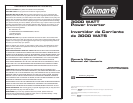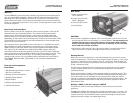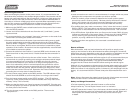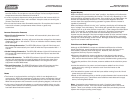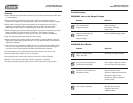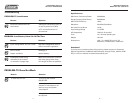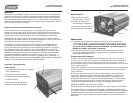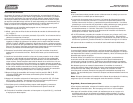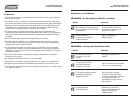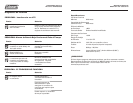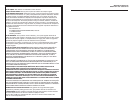
PMP3000 Models
Modelos PMP3000
Owner’s Manual
Manual del Usuario
Connecting the Inverter
When connecting the inverter to the power source, it is recommended to use
the thickest wire available in the shortest length possible. If the inverter and the
battery are positioned within 4 feet of each other, a minimum of #0 gauge wire
should be used to make the connections. When the distance between them is
4 to 6 feet, a minimum of #00 gauge wire is required. When separated by more
than six feet, contact a qualified technician to determine the appropriate wire
size to use given the distance between the inverter and the battery.
1. Make sure the ON/OFF power switch located on the front panel of the inverter
is in the OFF(O) position.
2. Loosen and remove the bolts and nuts from the red (+) and black (-) power
input terminals.
3. It is recommended to use a crimped “loop style” connector on the ends of the
cables when connecting the cables to the inverter.
4. Connect the cable wires to the power input terminals making sure to match
the color coded cables to the color coded terminals on the inverter (RED=
Positive, BLACK = Negative). Tighten the bolts and nuts to secure the cables.
Be sure not to over tighten. Note: A secure connection is essential to proper
operation of the inverter. Be certain to use the supplied bolts, nuts and wash-
ers included to connect the cables.
5. Connect the cable from the Positive (+) terminal (RED) on the inverter to the
Positive terminal on the power source. Double check that the connection is
secure.
6. Locate the Ground Lug Terminal at the rear of the inverter. Run a wire from
this terminal to a proper grounding point using the shortest practical length.
It is recommended to use a minimum of 12 AWG wire. You can connect
this wire to the chassis of your vehicle or to the grounding system in your
boat. As an alternative, when in remote locations the ground wire can be
connected to the earth (one way to accomplish this is to attach the wire to a
metal rod driven into the ground). Before connecting to the ground, make
certain that the inverter is turned off. Operation the inverter without correctly
grounding the unit may result in electrical shock.
7. Turn the inverter power switch to the ON(I) position. The LED Indicator Light
should illuminate GREEN to confirm that power is running to the inverter.
8. Turn the inverter power switch to the OFF(O) position. (The LED Indicator
Light may “blink” briefly and/or the internal audible alarm may make a mo-
mentary “chirp”. This is normal).
9. Make sure that the device you intend to operate is turned OFF. Plug the cord
from the equipment you wish to operate into one of the AC outlets located on
the front panel of the inverter.
10. Turn the inverter power switch to the ON(I) position. Then turn the
equipment on.
3
Notes
• Loose connections can result in a severe decrease in voltage, which may cause
damage to the component or the product you wish to operate.
• Failure to make a proper connection between the inverter and the power
source may result in reverse polarity. Reverse polarity will blow the internal
fuses in the inverter and may cause permanent damage to the inverter.
Damage caused by reverse polarity is not covered under the warranty.
• The audible alarm may make a momentary “chirp” when the inverter is turned
ON(I) or OFF(O). This same alarm may also sound when the inverter is being
connected to or disconnected from the 12-volt power source. This is normal.
• If the LED Indicator Light blinks when you first turn the inverter ON(I), this may
indicate an interruption of the power supply. Simply turn the inverter OFF(O)
and try removing and reconnecting the clamps. If this does not fix the
problem, try using a different 12-volt power source.
• If using more than one appliance, do not exceed a combined total of
3000 watts.
Source of Power
Most automobile, truck and marine batteries will provide an ample power
supply to the inverter for 30 to 60 minutes even when the engine is turned off.
Actual time may vary depending on the age and condition of the battery and the
power demand being placed on it by the equipment being operated.
If you decide to use the inverter while the engine is off, we recommend that you
start the engine every 30 to 60 minutes and let it run for approximately 10
minutes to recharge the battery. It is also recommended that the device
plugged into the inverter be turned OFF before starting the vehicle engine.
Although it is not necessary to disconnect the inverter when starting the vehicle
engine, it may momentarily cease to operate as the battery voltage decreases.
When the inverter is not supplying power, it draws very low amperage from the
battery. It is recommend that the inverter always be disconnected when not in
use.
Note: Always disconnect the power inverter from the 12-volt power source and
make sure the inverter is turned OFF before replacing the fuse.
Safety and Usage Precautions
• For best operating results, place the inverter on a flat surface
• Keep inverter dry. Do not expose inverter to rain or moisture.
• DO NOT operate the inverter if you, the inverter, the device being operated, or
any surface that may come into contact with the inverter are wet. Water and
other liquids can conduct electricity, which may lead to serious injury
or death.
4



